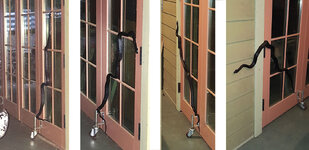Hello, I am 71, a scrap steel artist. I purchased a welder in January and although certainly still learning, have reached the point that I am now using welding to assemble components instead of using brackets and bolts. I hope I qualify to post here, if not please direct me.
My question is not about welding. I want to build what I will call a small dolly, fundamentally (operationally) like a furniture dolly, but with a full floor/deck, and large wheels for exterior terrain and a handle for manual or lawn tractor pulling. I'm looking for guidance regarding steel plate floor thickness as it relates to supports under it. I want to be able to make my sculptures on it and have part of my weight (a knee or two) on it while I'm working.
Dolly Size: 3' x 3' My weight: 215 lbs Typical Sculpture Weight: 50 to 250 lbs
My store-bought welding table top is 2' x 3' and about 5/32" thickness. It has 1-1/2 " x 3/4" x 3/32" rectangular tube supports around the perimeter and one across the middle. So I could use these specs to plan my dolly, but don't know if they are ideal, too little, or overkill for the dolly requireents.
My question is not about welding. I want to build what I will call a small dolly, fundamentally (operationally) like a furniture dolly, but with a full floor/deck, and large wheels for exterior terrain and a handle for manual or lawn tractor pulling. I'm looking for guidance regarding steel plate floor thickness as it relates to supports under it. I want to be able to make my sculptures on it and have part of my weight (a knee or two) on it while I'm working.
Dolly Size: 3' x 3' My weight: 215 lbs Typical Sculpture Weight: 50 to 250 lbs
My store-bought welding table top is 2' x 3' and about 5/32" thickness. It has 1-1/2 " x 3/4" x 3/32" rectangular tube supports around the perimeter and one across the middle. So I could use these specs to plan my dolly, but don't know if they are ideal, too little, or overkill for the dolly requireents.

